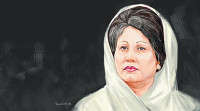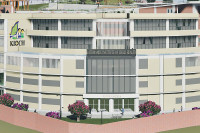Opinion
Macroeconomic risks
The budget could destabilise the macro economy and undermine the country’s development efforts
Tula Raj Basyal
Nepal’s economy is presently suffering from stagflation, which means output is stagnant and inflation is high. The rate of economic growth has decelerated in recent years. It is estimated to be 2.7 percent in 2015-16 and is projected to remain below one percent in 2016-17. The current rate of inflation is estimated to be 10 percent. Inflation has been attributed to supply-side disturbances and not factors related to demand-side management. The government budget for 2016-17 has not appreciated this fact, leave alone identified measures to address such structural issues to bring price stability. The budget opted for the easier political gimmick of distributing government resources without considering the short- and long-term impacts and implications of such a move. The nature and uncertainty of funding sources and their likely effects on the implementation of the budget has also not been considered.
Analysing the budget
The government’s annual financial plan for 2016-17 has substantially raised expenditure and reliance on foreign assistance, and debt inflows have been noticeably increased to finance it. Evidence from the past couple of years shows that the rate of foreign assistance utilisation has barely averaged two-thirds of the budget estimate. Also, the budget has not envisaged any credible policy or action to make the required changes in the existing implementation machinery and mechanism so that the implementation capacity and the utilisation of foreign aid can be improved. As a result, the implementation of the budget will be affected by uncertainty and unpredictability.
Coming to the numbers, the budget for 2016-17 has proposed a 56.6 percent increase in total expenditure (recurrent and capital) compared to 38.6 percent (revised estimate) in 2015-16. Presently, capital expenditure amounts to one-fourth and recurrent expenditure three-fourths of the total expenditure. In such a situation, increasing capital expenditure should have been the focus and priority of the budget. However, capital expenditure is projected to rise by Rs153 billion (45 percent of the increase) while recurrent expenditure is projected to swell by Rs183 billion (55 percent of the increase) compared to fiscal 2015-16. This means recurrent expenditure is projected to increase faster than capital expenditure. As a percentage of the Gross Domestic Product (GDP), recurrent expenditure and capital expenditure are expected to increase by five percentage points each between 2015-16 and 2016-17. Such a development will not produce the targeted impact on capital formation, employment creation and economic growth.
Non-debt sources of financing, namely revenue and foreign grants, are projected to reach 26.3 percent of GDP in 2016-17 compared to 21.2 percent in 2014-15. Likewise, the expenditure/GDP ratio is projected to reach 36.3 percent in 2016-17 compared to the actual ratio of 20.2 percent in 2014-15. Revenues are slated to rise 22.9 percent while revenues and foreign grants are estimated to swell 27.5 percent in 2016-17 over 2015-16. Consequently, the budget deficit for 2016-17 is projected to widen sharply and abruptly by almost 300 percent to Rs256 billion. This equals 10 percent of GDP from its revised estimate of 2.9 percent of GDP in 2015-16. Such a high budget deficit has never been seen in Nepal’s recorded history. The macroeconomic consequences of such an unprecedented level of deficit financing could be disastrous.
Unsound and risky
The risky budgeted framework of expenditure composition and sources of financing as contemplated in the budget for 2016-17 are likely to destabilise the country’s macro economy against the spirit of the constitution. The constitution has, as its directive principles, mentioned achieving rapid economic growth and sustainable economic development besides ending economic inequality. To pursue this objective, the constitution states that the government shall obtain assistance and borrow funds while maintaining macroeconomic stability in the country. However, the large deficit and other unrealistic aggregates of the 2016-17 budget are destined to make its implementation process uncertain. In such an environment, the objectives mentioned in the budget will be hard to achieve.
The projections of the budget aggregates for 2016-17 are based on unsound and risky assumptions. The structures of expenditure and financing sources will be distorted, resulting in unintended outcomes for the economy. Inflation is bound to worsen and people’s living conditions will deteriorate. The trade deficit will deepen and the balance of payments will weaken. Capital flight will be encouraged and foreign exchange reserves will be depleted. The savings, investment and employment outlook will be directly affected. The economy’s competitive and comparative advantages will decline. Due to an unfavourable investment environment and unstable macro economy, the projected economic growth will not be achieved. Foreign aid mobilisation and its utilisation will be weakened. Hence, the budget for 2016-17 can be termed as expansionary, inflationary and risky. The budget could destabilise the macro economy and undermine the country’s development efforts.
Basyal is a former executive director of Nepal Rastra Bank and former senior economic advisor to the Ministry of Finance




 5.4°C Kathmandu
5.4°C Kathmandu










%20(1).jpg&w=300&height=200)

